The 2014 Razer Blade Review
by Brett Howse on October 10, 2014 9:00 AM EST- Posted in
- Notebooks
- Gaming
- Laptops
- Razer Blade
System Performance
The Razer Blade continues to utilize the Intel Core i7-4702HQ CPU due to the timing of the launch. There are a couple of different choices at this time (i.e. i7-4710HQ) that were not around when the Razer Blade was refreshed. Compared to an Ultrabook, the Razer Blade is a full quad-core part with eight threads, so performance should be significantly better than the Haswell U series parts, but of course that is at the expense of power consumption, with the i7-4702HQ CPU rated at 37 watts. Coupled to this is an SSD in the Samsung PM851 and 8GB of DDR3L-1600 memory, which should provide excellent performance for day to day tasks.
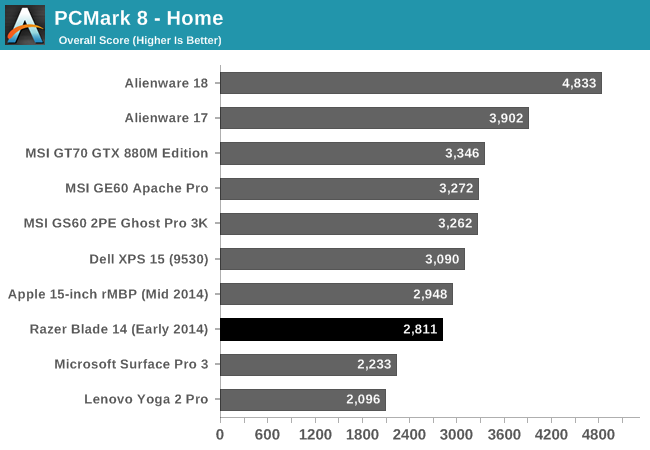
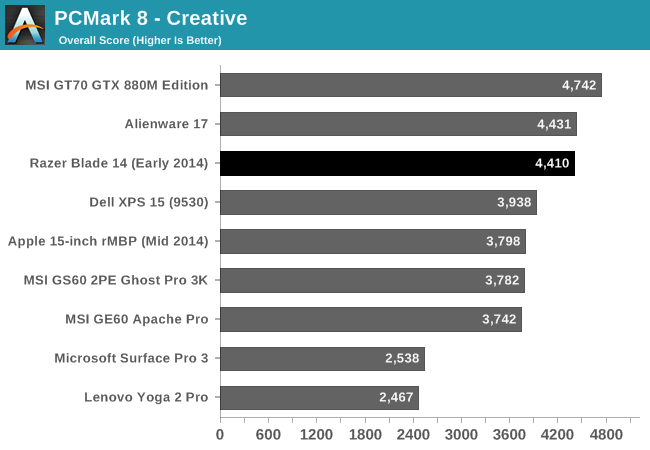

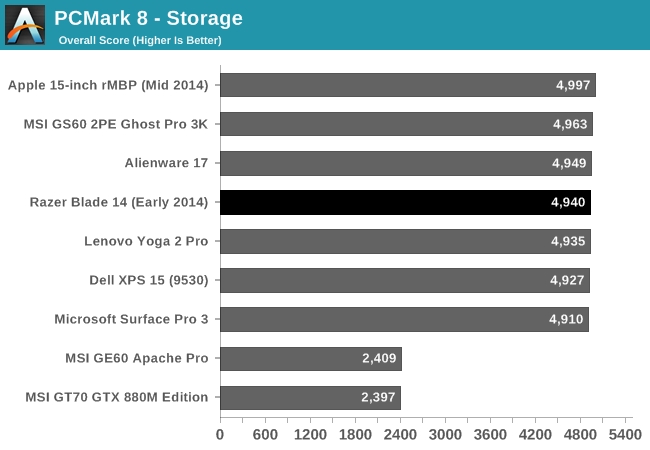
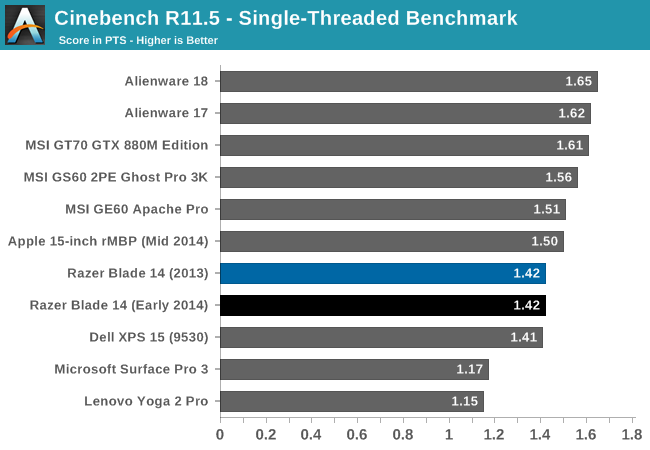
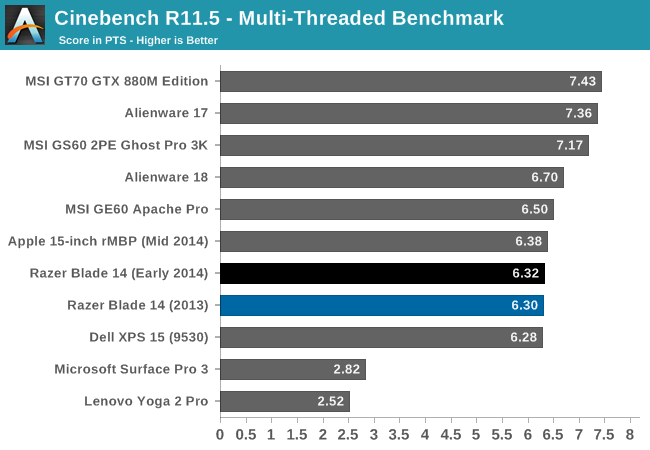
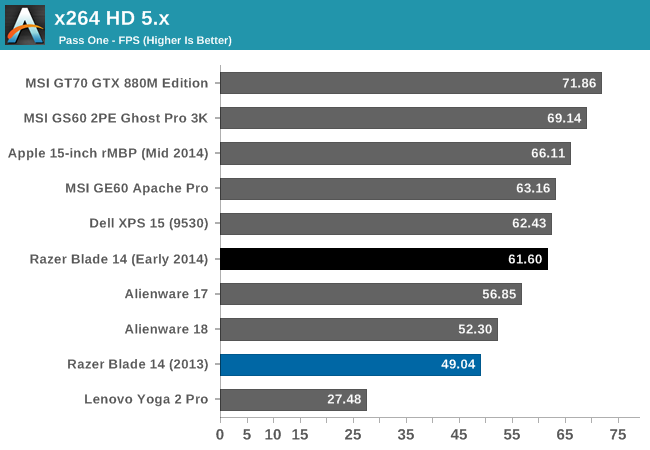
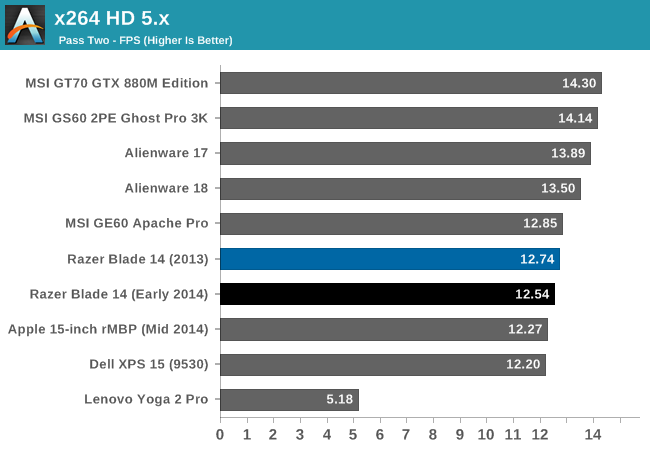
With the 37 watt CPU, the Razer Blade falls right where you would expect. Overall, there is more performance than the Ultrabook class machines such as the Yoga 2 Pro and the Surface Pro 3, but other gaming laptops with higher wattage CPUs are a bit faster. Still, for the Razer Blade’s intended use scenario, system performance is great. The M.2 SSD in the Razer Blade performs very well in the PCMark 8 Storage test, scoring very close to the rest of the SSD pack.
WiFi
The new Razer Blade has updated the WiFi card from the previous version that used a Killer Wireless-N 1202 dual-band 2x2 802.11a/b/g/n solution. The new Blade now features the Intel Dual-Band Wireless-AC 7260, which adds support for 802.11ac. This wireless card is a 2x2:2 card offering connection speeds up to 866 Mbps on an 802.11ac connection.
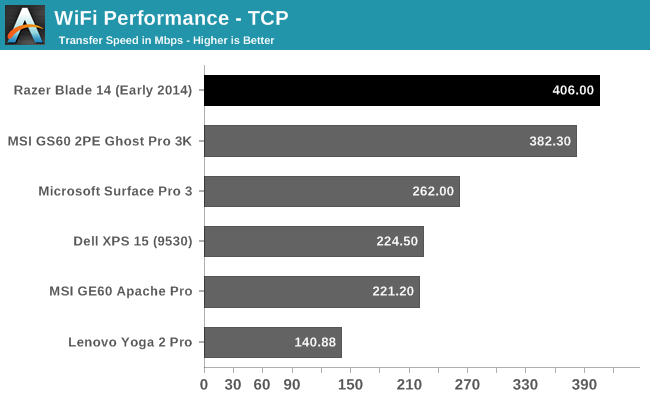
With around 400 Mbps sustained transfer speeds, the Intel wireless card does pretty well with the router close by, but in other tests Ganesh has found that the Broadcom BCM4352 card performs better, especially with some drywall between you and the router. With the Razer Blade 30’ from the router in another room, the wireless speeds dropped to around 270 Mbps, which is still a reasonable result. Still, the Blade has 802.11ac and therefore supports both 5 GHz and 2.4 GHz, so there is not too much to complain about here. The Intel card also performs the Bluetooth 4.0 functions.










69 Comments
View All Comments
TiGr1982 - Friday, October 10, 2014 - link
Indeed, as a new buy, the unit with Kepler-based GTX 870M became instantly obsolete at the day of release of Maxwell-based GTX 970M.Only an uninformed buyer will buy this now. Or, alternatively, a large discount may help.
TiGr1982 - Friday, October 10, 2014 - link
And 8 GB of RAM for this kind of pricing is not a good offer either.Niavlys77 - Friday, October 10, 2014 - link
Would be great to see a comparison to the Lenovo Y50 - I know it's 1080p screen is terrible, but I'm wondering how the 4k screen holds up to this IGZO panel.Friendly0Fire - Friday, October 10, 2014 - link
I'm fine with my current laptop (Asus UX51), but in a year or two I could see myself upgrading to this. Nvidia's Maxwell will probably make a significant difference on battery life and heat on a machine like this, so I'm excited to see the 2015 refresh.dmunsie - Friday, October 10, 2014 - link
For the gaming performance section, would it be possible to get the rMBP in there as well? Perhaps not OS X, since there is a lot not available on the OS X side. But certainly running Windows 8.1 would be doable and nice to know.frostyfiredude - Friday, October 10, 2014 - link
It has a GT750m, expect around 60% of the performance gotten by the 2013 Blade 14.aferox - Friday, October 10, 2014 - link
Would like to see this compared with the Gigabyte Aorus X3 Plus.frelledstl - Friday, October 10, 2014 - link
I just don't get the fascination with these higher than 1080p displays on a gaming notebook when the hardware just doesn't support that resolution with playable frame rates in newer games. At minimum if you are going to benchmark at 1080p, we need some kind of analysis on how the display handles scaling down to the lower resolution. 14 inches to me is the best size for a portable gaming laptop, but I can't help but think that something like the W230ss is just a better value for the money by far with its still nice 1080p IPS screen.. You can get a decent configuration of that for $1200-$1400 with a nice sized SSD and since the SS version is there 2nd gen version of that laptop, they have included some nice power optimization improvements. I think 2k-4k gaming is great, on a desktop that might stand a chance at actually providing decent frame rates at high detail settings.XabanakFanatik - Sunday, October 12, 2014 - link
I'll tell you from personal experience that I have played games accidentally set to 1080p and did not realize I was not at native resolution. A more thorough analysis of scaling would be nice, but I have no complaints.synaesthetic - Monday, October 20, 2014 - link
I raised this point myself but I noticed the non-standard resolution of 3200x1800. That's exactly four times 1600x900, which *is* a standard resolution. The performance figures at 1080p suggest that this laptop would run most games extremely well at 1600x900 and since the resolution is divisible four times into the native resolution, it shouldn't have any fuzziness or loss of sharpness from interpolation.